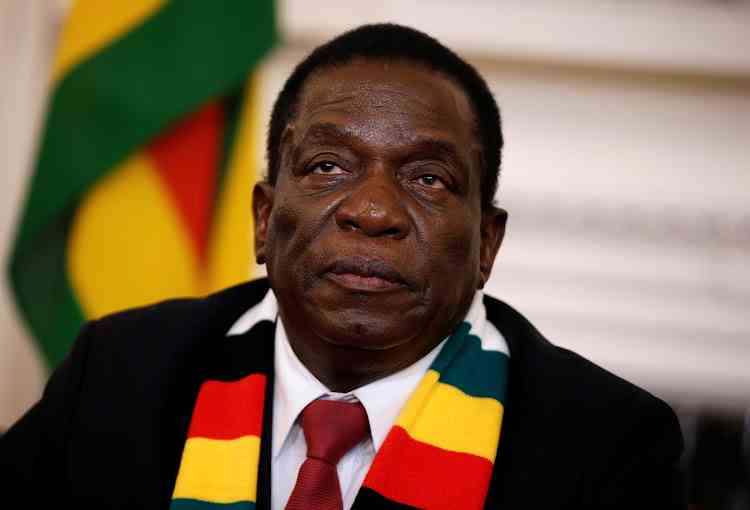
guest column Daniel Ngwira
Despite this and early green shoots, the economy continues to show vulnerabilities.
There are critical paths we can trace to show us where the economy took the turn for the worse and how a reversal can be instituted.
At times, the blame for a poorly performing economy or the credit for a well performing one go to the wrong people. In the United States, the previous administration lay the foundation for the good economy that the current administration is now being credited for.
In Zimbabwe, the current administration started from ground zero like President Obama did when he took office.
The inclusive government is remembered as the best period of economic prosperity in recent history.
Between 2009 and 2013, the cumulative trade balance was $19 billion while between 2014 and 2018 the trade balance cumulated at $13 billion. In terms of that statistic, the post inclusive government economy performed better. Yet during the inclusive government, we had no cash crisis.
There were no fuel queues. The lowest deficit, as per the graph below was in 2017, which ironically was the peak of cash shortages. The puzzle continues in that the biggest deficit was in 2011, during the inclusive government.
- Chamisa under fire over US$120K donation
- Mavhunga puts DeMbare into Chibuku quarterfinals
- Pension funds bet on Cabora Bassa oilfields
- Councils defy govt fire tender directive
Keep Reading
Bond notes and Gresham’s law
As the cash crisis was biting, debate over the introduction of bond notes ensued. The central bank embarked on a rare but commendable stance of consulting the market over the bond notes it had planned to introduce.
Public opinion rejected the notes as they were seen as a way of introducing the local currency which had failed due to hyperinflation. The central bank gave assurances that the printing of the notes will be within the limit as defined by a secured guarantee.
A currency board was also to be introduced to oversee the printing of the notes to ensure they were printed according to the original plan and limit.
Statistics do suggest that bond notes were printed responsibly contrary to the fear the public had. By the end of 2016, there were $70 million in circulation and by the end of 2018 only $502 million were in circulation. Considering broad money supply of $10 billion by end of 2018, the bond notes are a pie in the sky at 5%. Yet they are seen as the main reason why the economy has suffered. Gresham’s law was so named by economist Henry Macleod in 1860, several centuries after the death of Sir Thomas Gresham.
There were others who had observed the law before it was named after Gresham, a highly esteemed merchant and financier. The law states that “bad money drives out good.”
At the introduction of bond notes, the US dollar gradually disappeared in line with the theory. This gave rise to the parallel market as those who wanted the US dollar were prepared to pay a premium to give up the bond notes or electronic money. This is why in recent times exchange rates between the bond and the US dollar have been quoted in percentage terms contrary to global practice.
Foreign currency leakages and current account deficits
The country received $6,3 billion in 2018. Merchandise imports surged 28.45% from $5,462 billion in 2017 to $7,018 billion in 2018 driven by rising crude oil prices, consumer and industrial demand. Between 2017 and 2018, merchandise imports grew from $4,032 billion in the first three quarters of 2017 to $5,259 billion during the same period in 2018 on the back of a growing economy. Nonetheless the gap between foreign currency receipts of $6.3 billion and merchandise imports of $7 billion is too narrow to justify the movements on the parallel markets. There is a possibility that foreign exchange is leaking from the system.
Our cumulative trade balance between and including the years 2009 to 2018 is $32 billion (deficit) while the current account balance for the same period is $15,5 billion (deficit). This makes the country rely on cross-border capital flows, which over the comparable period have been a mere $3,4 billion. Thus, the economy has been and continues being vulnerable to diminished foreign investor appetite for Zimbabwe assets. This appetite has been and remains weak.
Money supply growth As not enough revenues were coming through to discharge government’s obligations, government printed money through issuing Treasury Bills. Essentially this entails that government was spending way more than it had budgeted for. Though some of the Treasury Bills had long tenors, a grey market for the discounting of the paper emerged through a cartel that was dominated by asset management companies and stockbrokers.
The money supply growth helped push up the parallel market rates further widening the gap between the official exchange rate and the black-market rate. Broad money (M3) supply increased from $4 billion in 2013 to $10 billion in 2018. An insignificant amount of the money supply growth went towards capital creation.
Import cover
In 2009, import cover was two months and in the last 10 years this was the peak. In 2018, the cover is merely two weeks. The question is if it was inappropriate to introduce a local currency when we had an import cover of two months, why would it be considered appropriate to do so when the cover has deteriorated to two weeks? What is clear is that during and after the inclusive government, the economy struggled to build up foreign exchange reserves.
This essentially means that the country has been living from hand to mouth. The decline in the import cover during the inclusive government can be explained by the fact that as the economy was characterised by shortages of products at the peak of hyper-inflation, government encouraged imports. Whereas business was supposed to be given more time to retool and prepare for production, they were competed out of the market due to high utility tariffs and antiquated equipment.
This essentially meant more reliance on imports. In the last 10 years of dollarisation, there has not been a deliberate viable program by government to support capital creation and hence production. Most of the national budget has being going towards recurrent expenditure, especially salaries. A serpent eating its own tail?
When an economy overheats, it may be a good idea to put in place some austerity measures. The economy is currently experiencing both a dislocation and a transformation.
The transformation to a more market-based economy would be easily welcome in the absence of a dislocation. The dislocation is characterised by fuel and power shortages as well as an increase in the cost base which is not corresponding with a rise in income. In fact, there is erosion of incomes across businesses and especially workers. Further, the dislocation is characterised by a sudden and deep erosion of balance sheets. Businesses use balance sheets to create more capital.
A bank which had capital of $25 million a year ago now has shareholders’ funds of just over $2,5 million. If this erosion persists, entrepreneurs may find themselves with no option but to close shop. Workers may, too, stop reporting for work as it becomes less sensible to do so.
Further the energy and power shortages mean that businesses cannot produce. This will further entrench the need to import. A transformation to market economics is painful but the current pain is more because of dislocation. Market economics always take us to an equilibrium at some point.
Why are the benefits of balancing the budget not filtering through?
There is no doubt that the National Treasury has tried to put in place measures to contain expenditure within the budget estimates. These measures include stopping reliance on issuing Treasury Bills to support government expenditure as well as the 2% tax.
Since December 2018, the country has been running budget surpluses yet the benefits of such have not filtered through the economy. One of the reasons is that government has been collecting more taxes compared to its expenditure. For instance, since October 2018, prices of goods have been running away. This means that government has been collecting more value added tax and 2% tax, while it had not adjusted its expenditure.
Citizens cannot enjoy the benefits because the surpluses are partly a result of inflation; revenue collected by Zimbabwe Revenue Authority (Zimra) is reflecting parallel market rates whereas government expenditure has been assuming an exchange rate of one is to one or that which lags the market.
This explains why Zimra has been surpassing its revenue targets against a backdrop of a poorly performing economy. In addition, the 2% tax is an excessive tax which, over time, diminishes the ability of citizens to spend. But that government has a surplus, is a good story to tell the world; the story is that government is living within its means.
Suffice to say that the ZWL$500 million surplus is only US$55 million. For the story to be credible, it must be complemented by the provision of basic services like water, power, energy and medicines which have been in persistent short supply. It does appear that there have been genuine efforts by government to live within its means.
Do budget deficits matter?
The economics of a balanced budget or budget surplus are simple to comprehend; they keep away government from borrowing and thus crowding out the market. Between the years 2007 and 2018, the USA budget deficit has been oscillating between 1,11% and 9.78% of GDP. In the national budget speech, the Ministry of Finance stated that the 2018 Budget Deficit was projected at $2,86 billion (11,7%) against a target of $793 million. The problem is essentially on how the out turn compares to the budget. In 2018, it can be noted that the two numbers were far apart.
There must always be good explanations as to how this is so. Was there an emergency that was unforeseen that caused the deficit to more than triple? Or was it simply a lack of discipline? Budget deficits are more justified when used to fund capital and job creation.
The projected budget deficit for 2019 is 5%. The budget deficit has been blamed for the expansion of the money supply and putting pressure on parallel market exchange rates. So, what could be the explanation for the “bull run” on parallel market rates at a time the country has a budget surplus?
The answer lies in lack of confidence and speculation. Budget deficits entail that a government is living beyond its means. But is that the best way to run financial affairs? The answer is it depends. China raised the 2019 budget deficit projection to 2.8% from 2.6% in 2018 in order to step up tax cuts and support more infrastructure spending to help stabilise the economy. China would use prudent monetary policy to avoid excess stimulus.
The tax cuts would mainly benefit the small-to-medium enterprises that were struggling due to restricted access to debt. In 2017 China had a deficit of 3,9%. Budget deficits expand the government’s room to spend and the more the government spends the more it stimulates the economy.
Budget deficits reward both the citizens and politicians in that politicians are rewarded by voters for creating jobs and economic growth while the citizens inevitably have an economic benefit in a booming economy. When both taxes and unemployment rise, politicians risk losing elections.
Employment and the burden on the work force
Statistics show that the total number of people employed in the United States of America is 157 million against a total population of 328 million people and an unemployment rate of 3,6%. This means on average one employed person supports one dependent.
The United Kingdom has an employed population of 32,7 million against a total population of 66,9 million and unemployment of 3,8%. one employed person, on average, supports one dependent. In South Africa, the number of employed people is 16 million against a population of 57,73 million implying that on average one employed person supports nearly 3 dependents. Unemployment rate is 27,6%. Zimbabwe population is 17,2 million.
The number of formally employed people is estimated at around 800,000, having fallen from 2 million in year 2000. This means that one employed person supports 20 people.
Why is the parallel market rate spiking?
A close analysis into the movements of the parallel market rates shows that in all the cases where there was a sharp rise, government or key figures in government would have made statements that give the market the signal that bond notes will be demonetised, the notable such sharp depreciation of the bond notes being in October 2018.
This was exacerbated by the 2% tax which resulted in a sharp increase in the cost of financial and business transactions. In April 2019, the sharp rise in the dollar against the ZWL followed the same pronouncement. Yet there is what I would call the fuel factor. As long as there is a shortage of fuel, the signal to the market is that the foreign currency situation is desperate. This pushes up the dollar price.
Worse still the shortages of fuel and power happening during the tobacco selling season, does not give confidence to the market. As a result, market players have been stampeding into the greenback for cover thus further depreciating the ZWL.
It is also inevitable that the role of speculators fuels the market. An important factor that has driven the parallel market where it is today is the lack of confidence.
This has been made worse by what the market perceives as the partial liberalisation of the inter-bank market. Analysts believe that full liberalisation could have helped in crashing the parallel market thereby achieving convergence. There is a test case where in 2004 the Reserve Bank of Zimbabwe introduced the foreign currency auction system worked briefly before the market lost confidence as it became apparent that the exchange rate was being manipulated.
The way forward
It is imperative to stabilise the economy which is increasingly becoming weak.











